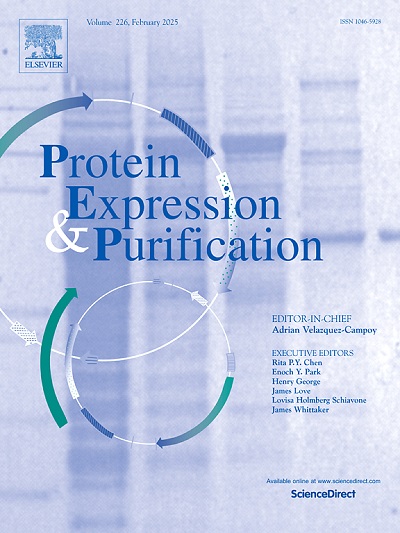A new combination approach to extracellular production of 5-aminolevulinic acid for purification and application in alleviating cadmium-induced oxidative stress in maize
IF 1.2
4区 生物学
Q4 BIOCHEMICAL RESEARCH METHODS
引用次数: 0
Abstract
5-Aminolevulinic acid (ALA) is widely applied in agriculture, animal husbandry, medicine, and often manufactured in Escherichia coli for overexpressing ALA synthase (ALAS) from α-proteobacteria. For enhancing extracellular ALA production, several approaches have been exploited. Here, we developed and identified a new combination strategy to increase ALA production in E. coli, including selection of the negatively-charged peptide tag as a C-terminal fusion partner for increasing soluble production of the ALAS codon variant from Rhodobacter sphaeroides, mutation of certain residues to increase the ALAS variant activity, optimization of the signal sequences to facilitate ALA secretion, down-regulation of the hemB to inhibit ALA transformation in one plasmid expression system, and supply of 4 mM dithiothreitol to the culture to increase cells tolerant to the oxidative stress. Under the specified cultural conditions, ALA yield was up to 3.2 g/L in flash flasks. Compared with the added cadmium-induced stress, simultaneous supply of purified ALA improved maize seedlings growth, decreased contents of malondialdehyde and hydrogen peroxide, and increased peroxidase activity, contents of chlorophylls and proline.
细胞外合成5-氨基乙酰丙酸的新方法及其在镉诱导玉米氧化应激中的应用
5-氨基乙酰丙酸(ALA)广泛应用于农业、畜牧业、医药等领域,常因α-变形菌中ALA合成酶(ALA)过表达而在大肠杆菌中制造。为了提高细胞外ALA的生产,已经开发了几种方法。在这里,我们开发并确定了一种新的组合策略来增加大肠杆菌中ALA的产量,包括选择带负电荷的肽标签作为c端融合伙伴来增加球形红杆菌中ALAS密码子变体的可溶性产量,突变某些残基以增加ALAS变体的活性,优化信号序列以促进ALA的分泌。在一个质粒表达系统中下调hemB以抑制ALA转化,并向培养物中提供4 mM的二硫苏糖醇以增加细胞对氧化应激的耐受性。在规定的培养条件下,闪蒸瓶ALA产量可达3.2 g/L。与添加镉胁迫相比,同时供应纯化ALA改善了玉米幼苗的生长,降低了丙二醛和过氧化氢含量,提高了过氧化物酶活性、叶绿素和脯氨酸含量。
本文章由计算机程序翻译,如有差异,请以英文原文为准。
求助全文
约1分钟内获得全文
求助全文
来源期刊

Protein expression and purification
生物-生化研究方法
CiteScore
3.70
自引率
6.20%
发文量
120
审稿时长
32 days
期刊介绍:
Protein Expression and Purification is an international journal providing a forum for the dissemination of new information on protein expression, extraction, purification, characterization, and/or applications using conventional biochemical and/or modern molecular biological approaches and methods, which are of broad interest to the field. The journal does not typically publish repetitive examples of protein expression and purification involving standard, well-established, methods. However, exceptions might include studies on important and/or difficult to express and/or purify proteins and/or studies that include extensive protein characterization, which provide new, previously unpublished information.
 求助内容:
求助内容: 应助结果提醒方式:
应助结果提醒方式:


